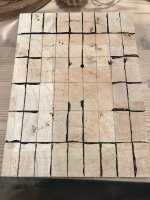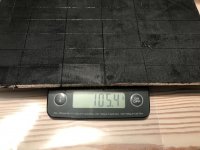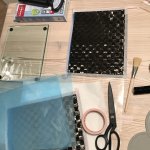Thanks for the tips and info about the patent!
If I'm reading it right, (English isn't my native language) the idea of Akylyte panel isn't bad at all because of the way it's made. As I would have it printed, I can not add another skin to the front. For the rear I could experiment of course.
I think I might have to add a frame and suspension as well after reading 😉
If I'm reading it right, (English isn't my native language) the idea of Akylyte panel isn't bad at all because of the way it's made. As I would have it printed, I can not add another skin to the front. For the rear I could experiment of course.
I think I might have to add a frame and suspension as well after reading 😉
↑↑ @proxii
I am not all that sure about how polypropylene would sound, but the way it is made is interesting, a honeycomb. And, it is cheap, for the first try. I've a feeling that these kind of boards are there in construction material shops (OBI, Action) and advertising material shops. It would be better, if you can see it and tap on it to hear how it sings. You are in Netherlands, I believe. Anyway, try to read that patent pdf with a translator. You'd lose a few days, but understand a lot after. Just ignore the equations/formulae, read just the needed stuff.
I am not all that sure about how polypropylene would sound, but the way it is made is interesting, a honeycomb. And, it is cheap, for the first try. I've a feeling that these kind of boards are there in construction material shops (OBI, Action) and advertising material shops. It would be better, if you can see it and tap on it to hear how it sings. You are in Netherlands, I believe. Anyway, try to read that patent pdf with a translator. You'd lose a few days, but understand a lot after. Just ignore the equations/formulae, read just the needed stuff.
Further to post #8,860
About damping
The first point reminds me of the 'under damping' of the Göbel patent.
About damping
- The suspension/surround may damp the edges of the radiator panel to prevent excessive edge movement of the panel without generally preventing desired edge vibration.
- Additionally, or alternatively, further damping may be applied as patches, bonded to the panel in selected positions to control particular frequency modes in damping excessive movement, and help distribute resonance more equally over the panel.
- The patches may be of bitumen-based material, as commonly used in conventional loudspeaker enclosures or may be of a resilient or rigid polymeric sheet material.
- Some materials, notably paper and card, and some cores may be self-damping.
- Where desired, the damping may be increased in the construction of the panels by employing resiliently setting, rather than rigid setting adhesives.
- Effective said selective damping includes specific application to the panel including its sheet material of means permanently associated therewith.
- Edges and corners can be particularly significant for dominant and less dispersible low frequency vibration modes of panels hereof.
- Edgewise fixing of damping means can usefully lead to a panel with its said sheet material fully framed, though at least their corners can often be relatively free, say for desired extension to lower frequency operation.
- Attachment can be by adhesive or self-adhesive materials.
- Other forms of useful damping, particularly in terms of more subtle effects and/or mid and higher frequencies can be by way of suitable mass or masses affixed to the sheet material at effective medial localised positions of said area.
The first point reminds me of the 'under damping' of the Göbel patent.
Not true.But, you'd never find any mention about a bare radiator panel (a bare sheet) freely hanging from strings, or about an unsupported panel anywhere in it, or in any other patents, for that matter.
Why start with 2 excitors per panel?... I'll be using two exciters per panel, and one panel per channel. (I'm going stereo) I think I'll use the DAEX25FHE-4 and DAEX32EP-4 unless I'm told otherwise. 🙂
One can produce extraordinary sounding DMLs with single exciters.
Don't complicate something before you have a reason to do so.
Start simple.
And, further on damping...and cutting...

Two materials are shown here, to illustrate the idea.Other measures, indicated dashed in figure above, include cutting partially (22C) into the core (22) through one skin (21) or adding damping or stiffening material/members (22S) as inner framing at least partially about the intended operative area, thereby reducing some of preferential size for the panel member structure concerned.
Some people, by the way, had been talking about adding weights, patches etc as their own inventions. 🙂The radiator panel is a rigid lightweight laminated sandwich-type panel having a core (22) e.g., of rigid plastics foam (97) or cellular matrix (98) such as a honeycomb matrix of metal foil, plastics or the like, with the cells extending transversely to the plane of the panel, and closed by opposed skins (21), e.g. of paper, card, plastics or metal foil or sheet.
For sure not me, not with a panel over 40 mm thick!↑↑
Ah, Heron's, anyone made that? 🙂
Eric
Why not?Why start with 2 excitors per panel?
Two exciters per channel is quite a good idea. #8,761
I'd have made the radiator panel about 560 mm x 360mm, so the whole loudspeaker would become about 600mm x 400mm, and about 50-60mm thick. Would be compact and probably hi-WAF. But I won't go for the grills. The back will be completely covered and damped. Maybe some bass-reflex holes on the side. Or, maybe use the golden ratio 1.618, they say pleasing to the human eye. 🙂 Fixed on the wall like a picture. NXT was talking about shallow enclosures. #8,733
Last edited:
I think the Akylite is worth a try, but since I haven't tried it myself I couldn't say for sure.Could someone perhaps help me with deciding which material would be best? I have a windows PC as a source, and I am using an Umik-1 + REW and Windows APO to be able to EQ everything a bit.
The materials I've looked at;
3mm Dibond; https://company7.nl/en/product/print-op-dibond/
2.9mm Akylite: https://company7.nl/en/product/akylite-plex/
1/3/5mm Forex: https://company7.nl/en/product/foto-op-forex/
I have tried Dibond, and it's way too heavy.
I have not tried Forex, but have tried other lightly foam PVC panels, and they too are heavy and not stiff. Probably Forex is too.
Eric
Thank you, this is the one I found in the patent you linked. Have you seen other places mention of cuttings?Here's another mention of cuttings (it is in the patent I linked)
View attachment 1134466
It is a NXT finding. I have no knowledge of the scientific reasons for that, except what NXT says. 🙂
I filled grooves and cuts with polyurethane sealant. On another panel also sealed the end grain balsa pores with it.
Attachments
Hi Pixel1,In the Dm 500 ecc tectonic panels seems to be connected to the frame only on 4 points on the long side, I'm not sure about this but it seems like this, instead you say to insert soft material between the panel and the frame but basically it is a fairly rigid connection. Another thing is to use the suspensions of the normal loudspeaker but isn't this in contrast with what you were saying that if it is free it is not a DML? In any case, the suspension of the loudspeakers is complex
The Tectonic panels seem to be connected rigidly to the frame at the 4 points and by soft material on more than 50% of the length of each of the four sides.
Check the link below for a better view.
Eric
https://tectonicproaudio.com/about-the-technology/
You've deduced all this from your vast range of personal experience and testing?👏👏😏😴🥴🥺🥱Why not?
Two exciters per channel is quite a good idea. #8,761
View attachment 1134785
I'd have made the radiator panel about 560 mm x 360mm, so the whole loudspeaker would become about 600mm x 400mm, and about 50-60mm thick. Would be compact and probably hi-WAF. But I won't go for the grills. The back will be completely covered and damped. Maybe some bass-reflex holes on the side. Or, maybe use the golden ratio 1.618, they say pleasing to the human eye. 🙂 Fixed on the wall like a picture. NXT was talking about shallow enclosures. #8,733
Last edited:
Chdsl.
I would also add, that I would never recommend buying something that I had not tried and tested myself, even more so to a new visitor to the forum, who might think you understood what you were talking about.
think about what you are saying.
Steve.
I would also add, that I would never recommend buying something that I had not tried and tested myself, even more so to a new visitor to the forum, who might think you understood what you were talking about.
think about what you are saying.
Steve.
More money.Why not?
Two exciters per channel is quite a good idea. #8,761
View attachment 1134785
I'd have made the radiator panel about 560 mm x 360mm, so the whole loudspeaker would become about 600mm x 400mm, and about 50-60mm thick. Would be compact and probably hi-WAF. But I won't go for the grills. The back will be completely covered and damped. Maybe some bass-reflex holes on the side. Or, maybe use the golden ratio 1.618, they say pleasing to the human eye. 🙂 Fixed on the wall like a picture. NXT was talking about shallow enclosures. #8,733
More complicated.
More bits to fall off.
More bits that may need tweaking.
More wiring and/ or more amplifiers.
No objective proof that multiple exciters work better than single ones that I've seen.
Problem is you havent made/built it yet. An opinion without any actual experience to back it up is moot. Just like how you claimed that the design pattern on that panel (that you said looks like a Japan flag) has no value audio wise and is only used to empty ones purse.Why not?
Two exciters per channel is quite a good idea. #8,761
View attachment 1134785
I'd have made the radiator panel about 560 mm x 360mm, so the whole loudspeaker would become about 600mm x 400mm, and about 50-60mm thick. Would be compact and probably hi-WAF. But I won't go for the grills. The back will be completely covered and damped. Maybe some bass-reflex holes on the side. Or, maybe use the golden ratio 1.618, they say pleasing to the human eye. 🙂 Fixed on the wall like a picture. NXT was talking about shallow enclosures. #8,733
So, how many complete speakers/speaker systems have you made, since 2014? Can you show a picture of just one system? 🙂Chdsl.
I would also add, that I would never recommend buying something that I had not tried and tested myself, even more so to a new visitor to the forum, who might think you understood what you were talking about.
think about what you are saying.
Steve.
Yes, I do. Yours is a resonance box, not a distributed mode loudspeaker, even if the creation looks stunning. 🙂You've deduced all this from your vast range of personal experience and testing?👏👏😏😴🥴🥺🥱
Simple, that's all in the NXT patents. Tectonic labs, the owner of the intellectual property of HiWave Tech/NXT does exactly that. There's also someone here, who most times silently listening in, making them for a living with his team. In a way, that opened my mind to the correct direction. The best is for the newcomers or those still to make a distributed mode loudspeaker is not to make the same mistakes of the "gurus." Better read the documents/patents than get headaches later. Most here think that they have a distributed mode loudspeaker, but do they?No objective proof that multiple exciters work better than single ones that I've seen.
Last edited:
- Home
- Loudspeakers
- Full Range
- A Study of DMLs as a Full Range Speaker


